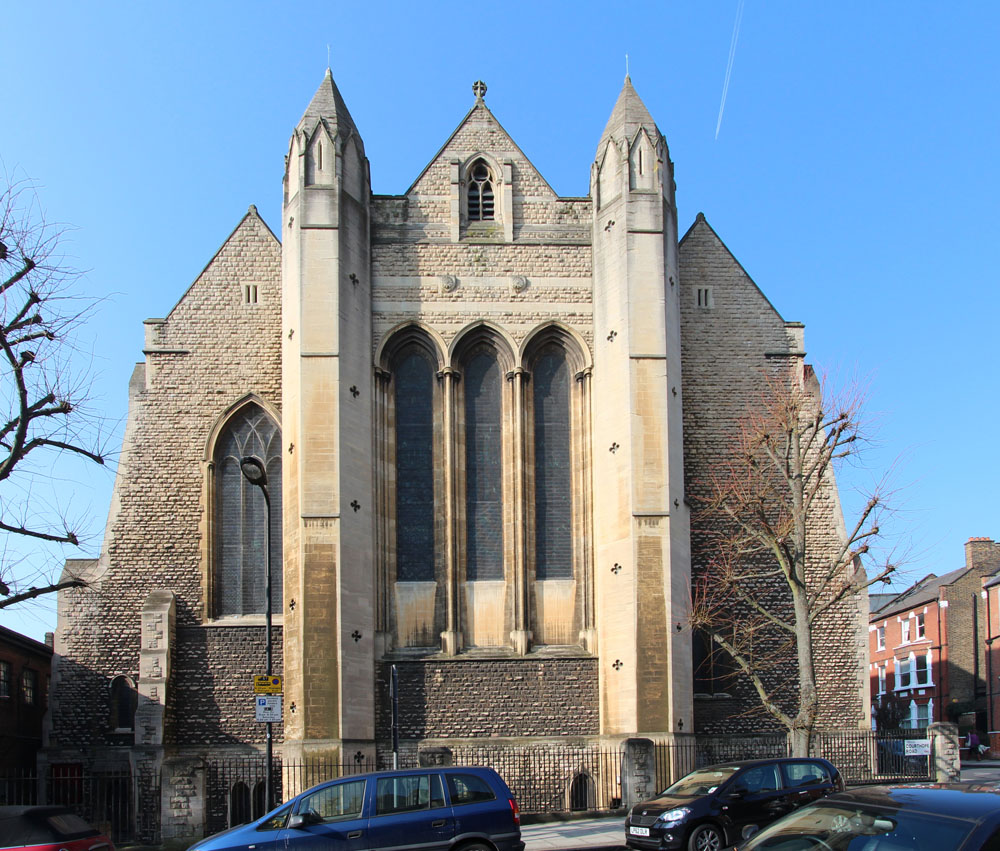Photographs by John Salmon. You may use the images without prior permission for any scholarly or educational purpose as long as you (1) credit John Salmon and (2) link your document to this URL in a web document or cite the Victorian Web in a print one. Click on the images to enlarge them.

All Hallows, originally designed as The Church of the Good Shepherd), Gospel Oak, by James Brooks (1825-1901). This impressive church covers the largest parish in Hampstead, made up of the old parish of St. Stephen's, Hampstead, and All Hallows' North St. Pancras (see "History of All Hallows'"). The cornestone was laid with great ceremony in 1892 and the nave was consecrated on 23 January 1901 (see "History of All Hallows'"), so it just creeps into the Victorian period. However, it was not finished: only after Brooks's death was the chancel completed, to a "revised design," by Sir Giles Gilbert Scott in June 1914 (Roberts and Godfrey 139). The church is of Ancaster stone with ashlar dressings, and stands on Savernake Road, on the corner of Shirlock Road, with its east end facing what was then the recently laid Courthope Road, in Gospel Oak, North London.
West Front



Left to right: (a) West entrance tympanum. (b) Jesus in the centre, as the Good Shepherd with a sheep. (c) The great west wheel window.
Impressively tall despite not having the flèche or timbered turret and western bellcote that Brooks had had in mind, the church shares the "bold, severe dignity" of his East End churches (qtd. in "Mr Brooks's Churches" 108). It has been described as a "cathedral-like fragment" and "Brooks's masterpiece" (Cherry and Pevsner 343). For the tympanum over the west entrance facing the busy Savernake Road, Brooks has used a gothic-window motif with the canopied figure of the Good Shepherd in between, while above is an elegant example of a wheel window with the central circle allowing ample space for the stained-glass image of Christ in Majesty surrounded by saints and angels — only partially filled now, but illustrated in all its projected glory in a framed cartoon [see here] inside the church.
East End


Left: The east end, on Courthope Road. Right: North-east view.
Brooks is not as well known now as some of his peers, but Geoffrey Tyack tells us that "in the last twenty years of his life he became one of the most prolific of English church architects." Sadly, as noted above, he died before the structure of All Hallows was finished, and this end was completed by Giles Gilbert Scott. Still, its massiveness and corner turrets clearly derive from the original plan. Scott has simplified the window arrangement, but the three tall narrow lancets, which emphasise its height, match those of the nave. The corner turrets are also rather like the ones at Scott's own Charterhouse Chapel, which may suggest some influence from Brooks. They too serve to emphasise the church's height. The aisles are as high as the nave, so the three-quarter view from the north side, with the height and also the length dramatically apparent, as well as the stout buttressing, probably makes the greatest impact of all.
North Porch


Left: The north porch, at the west end. Right: The Last Supper, beside the arch here.
The north porch has three gables that echo the nave and two aisle roofs, and that sport architectural motifs recalling those on the tympanum of the west front. It is flanked by examples of the buttresses that give such an air of solidity to the church. To the right of the entrance, a bronze plaque bearing a relief of the Last Supper welcomes people into fellowship with the rest of the congregation. Andrew Saint reminds us that "the churches had to compete for souls" with other houses of worship and indeed with other more worldly attractions (25), and perhaps such plaques, placed on outside walls, were symptomatic of this. Church photographer John Salmon, who took all these photographs, reports that he has seen a good number of similar ones.
Related Material
- Brooks's original idea of the church
- II: Interior
- III: Fixtures and Fittings
- Stained glass by Powell & Sons
Sources
"History of All Hallows' Church" (Church website). Web. 25 August 2015.
Cherry, Bridget, and Nikolaus Pevsner. London 4: North. New Haven and London: Yale University Press, 2002.
"Mr Brooks's Churches." Architecture, Vol. 4. 20 August 1870: 108. Google Books. Free Ebook. Web. 25 August 2015.
Roberts, Sir Howard, and Walter H. Godfrey, eds. Survey of London, 1900. Vol. XXIV. Part IV. London: London County Council; London Survey Committee; Joint Publishing Committee Representing the London County Council and the London Survey Committee, 1900. Internet Archive. Contributed by Robarts Library, University of Toronto. Web. 25 August 2015.
Saint, Andrew. "The Late Victorian Church." The Victorian Society Studies in Architecture and Design, Volume Three: Churches 1870-1914. Eds. Teresa Sladen and Andrew Saint. London 2011. 7-25.
Tyack, Geoffrey. "Brooks, James (1825–1901), architect." Oxford Dictionary of National Biography. Online ed. Web. 25 August 2015.
Created 25 August 2015